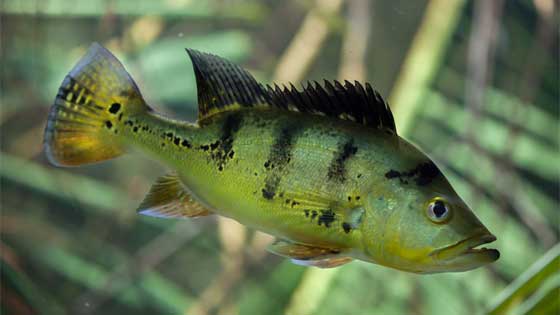Butterfly Peacock Bass Autumn Fishing

Use shallow running floating and diving plugs for lagoon and slow water conditions with blue, chartreuse and green and white plugs working best.
Summer is the best time for fishing Butterfly Peacock Bass and these conditions continue over into fall. The Peacock bass species prefer the heat and sunlight, and only head to deeper water in the high heat of tropical summers.
These are not a night time fish like the largemouth and smallmouth bass. Nor do they like to feed in the dusk and dawn hours. Once the sun is up and hitting the water, the Butterfly Peacock Bass come out.
Water conditions in the early fall are just as ideal for Peacock Bass fishing as they are in the summer months.
Fishing Gear
Baitcast Reels
Choose a baitcast reel with a large spool size, say around 120 yards (about 110 meters). I hope we haven’t scared you into thinking that you need a reel suitable for a marlin in order to catch Peacock Bass. Focus on a reel with durable gears and a very smooth drag as you’ll be fighting the peacock for a long time before landing it.
Rods
We recommend a 6 foot 6 inch rod that is graded for heavy action. The length of the rod is designed to better enable you to retrieve and cast large topwater lures.
When water levels are high, peacocks are hard to catch. They’re not trapped by lagoons and have so much more debris that they can swim through to loose a line. Lines get tangled and they are much harder to find when the water levels are high because they are scattered over a greater distance rather than being concentrated in a single area.
As water levels drop off at the beginning of the dry season, the Peacocks retreat into lagoons and landlocked lakes and are much easier to catch, providing you have the proper fishing gear and equipment. Peacocks are considered to be the most ferocious fighters for their size.
Make sure to loosen your drag as the peacock hits with shocking force and can break your line and rod if you don’t let up on the drag. Once the hook is set, tighten up the drag before it takes all your line. These fish put up a strong fight, making repeated short jumps so don’t give up when they are close to the boat.
Fishing Line
The line strength must be at least 20lbs, but 40 lbs is recommended as a large lunker of 25+ pounds can be challenging to reel in on a 20 pound test line.
The bass are much bigger in South America than they are in Florida and it requires more skill. The increased skill level is because of the extra debris in the water, greater size and weight range and more remote locations. Make sure you’re well equipped with heavy strength tackle gear as these monsters will send you home in a hurry if you come with anything less.
Use shallow running floating and diving plugs for lagoon and slow water conditions with blue, chartreuse and green and white plugs working best. Lipless rattling crankbaits are a favored lure in open water fishing conditions with blue and silver working best.
Spinnerbaits will work but plugs are a much better choice and will give you more success. Unless you don’t have any other lures, leave spinnerbaits home when fishing peacock.
These lure techniques also work well in Florida waters along with live baits. The key is to appeal to their instinct to defend their territory.



